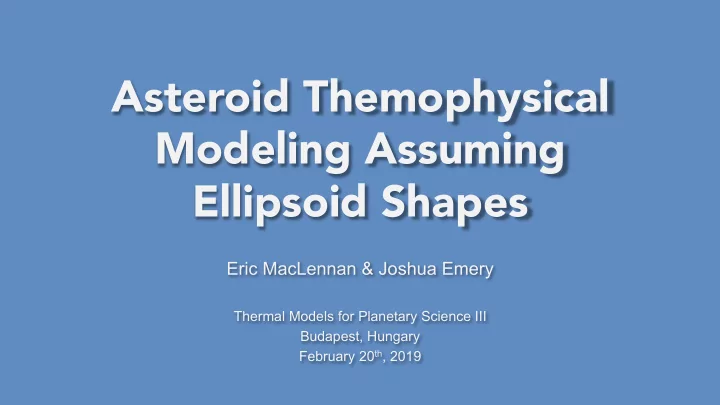

Asteroid Themophysical Modeling Assuming Ellipsoid Shapes Eric MacLennan & Joshua Emery Thermal Models for Planetary Science III Budapest, Hungary February 20 th , 2019
Outline Ellipsoid Shape TPM Method • ‘Traditional’ Approach • Description & Application • Validation Testing Implementation & Analysis • Thermal Inertia of objects observed by WISE • Thermal Conductivity/Grain Size Modeling • Asteroid Population Grain Size Analysis
‘Traditional’ TPM Bennu 1. calculate surface energy (from Emery et al., 2014) budget across shape model 2. numerically solve the 1-D heat diffusion equation for each shape facet (top) 3. calculate the emitted flux from surface temperatures 4. integrate over entire surface to calculate emitted flux value for desired wavelength(s) 5. adjust TPM parameters to find best-fit to the data
Ellipsoid TPM sphere ellipsoid 1. calculate surface energy budget across sphere 2. numerically solve the 1-D heat diffusion equation for each facet 3. transform surface temperatures to prolate (b = c) ellipsoid 4. calculate the emitted flux from surface temperatures 5. integrate over entire surface to calculate emitted flux value for desired wavelength(s) 6. extract lightcurve mean and amplitude 7. adjust TPM parameters and spin axis to find best-fit to *multi-epoch* data
Multi-epoch Data • pre-/post-opposition data guarantee 𝛥 = 40 (SI) 𝛥 = 40 (SI) The image cannot be displayed. Your computer may not have enough memory to open the image, or the image may have been corrupted. Restart your computer, and then open the file again. If the red x still observations of morning & afternoon appears, you may have to delete the image and then insert it again. • sense of spin determines morning/ afternoon temperate asymmetry • thermal inertia affects the flux change as a function of phase angle 𝛥 = 2000 𝛥 = 200 𝛥 = 200 (SI) 𝛥 = 200 (SI) 𝛥 = 40 ng Afternoon Mo Morni ning Af 100 142 185 227 270 Temperature (K)
Validation using Synthetic Dataset convex asteroid shape surface temperatures model from DAMIT pre-select TPM parameters, D eff , Γ, etc. search for parameter fit ellipsoid models to calculate multi-epoch combination that flux dataset emitted flux minimizes chi-square
Validation Results • The best-fit diameter b closely follows the expected (model) diameter, within 10%
Validation Results • The best-fit thermal d parameter closely follows the synthetic (model) thermal parameter, Θ
TPM Results on WISE Data Inverse relationship between thermal inertia and asteroid size Analysis: 1. Use thermal inertia in a thermal conductivity model to estimate the grain size 2. Run multivariate model on grain size data
Thermal Conductivity Model Model effective thermal conductivity: Observed effective thermal conductivity: k eff = a + b T 3 k eff eff = = 𝛥 2 C C k eff = k gas + k solid + k rad C = ρcϕ , heat capacity Gundlach & Blum ρ , grain density (2013) c , volumetric heat capacity ϕ , porosity • a & b from G&B (2013) • use spectral classification to infer the grain density and heat capacity • assume several values of porosity to account for uncertainty
Grain Size Estimation ρ , c & other material properties thermal conductivity model run 1 million times d ϕ = log 2 (2r g )
Grain Size Results & Model Fit Used multivariate linear model to fit a linear function to grain size (dependent variable) and both independent variables (diameter and rotation period)
Compositional Differences grain sizes of S-types are slightly below grain sizes of P-types are below average, E- average types slightly above average M-types exhibit 4 x greater regolith grain size
Thank You!
Compositional Properties ρ ≈ 3500 kg m -3 • Link spectral groups with meteorite analog c ≈ 650 J kg -3 K -1 • Use meteorite ρ , c in conductivity model k solid ≈ 4 Wm -1 K -1 ρ ≈ 2700 kg m -3 c ≈ 650 J kg -3 K -1 k solid ≈ 0.6 Wm -1 K -1 ρ ≈ 7500 kg m -3 c ≈ 400 J kg -3 K -1 k solid ≈ 25 Wm -1 K -1 E p V > 0.42 M 0.12 < p V < 0.42 P p V < 0.12
Regolith Generation & Loss impact generation & ejection of regolith impact gardening of existing regolith M-t -types – – diff comp mposition or me mechanical property? estimated weathering timescale is 750 kyr – 1.5 My, above trend is consistent with modeling prediction which is longer than lifetime of a 1 km asteroid (200 kyr) of fast sunrises = greater thermal stress (Basilevsky et al., 2013; Holsapple et al, 2002) (Molaro & Byrne, 2012)
Recommend
More recommend